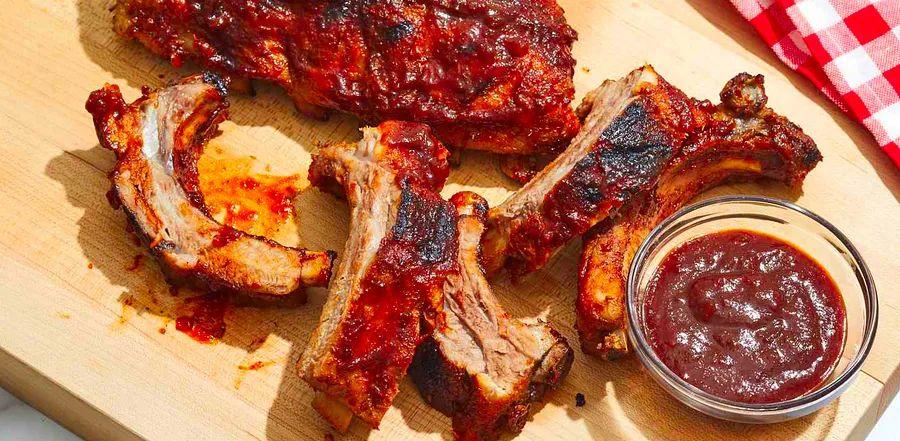Spare Ribs vs. Baby Back Ribs: What Sets Them Apart and Which One is Superior?

By their names alone—spare and baby back—you might think one set of ribs is smaller than the other, and you'd be right. But while size does play a role, it's not the only factor that differentiates these two cuts of pork. Let’s take a closer look.

Spare Ribs
Spare ribs are anything but minimal, making up the larger portion of the rib section along the side and into the belly of the pig. With their substantial size, hearty meat, distinct bones, and generous fat content, spare ribs are widely regarded as the most flavorful and a top choice for barbecues and social gatherings.
Spare ribs sit below the baby back ribs and, when sliced, reveal a prominent ridge on one side where the marrow is exposed, showing where they once connected to the baby backs. The other side may feature gristle and cartilage, marking its attachment to the chest.
The USDA mandates that a slab of spare ribs contain at least 11 bones. Though there's minimal meat on top of the bones, the spaces between them, known as flap meat, are packed with flavor. These meaty sections, once part of the diaphragm, deliver the satisfying bites you crave when holding a rib in each hand.
Often trimmed to remove any remnants of breastbone or tough cartilage, spare ribs are shaped into a neat, rectangular slab known as St. Louis-style. Their flatness allows for more even browning during cooking, but their larger size means they require a longer cook time than their smaller baby back counterparts.
A slab of spare ribs typically weighs between 2 ½ to 3 pounds. With plenty of marbled fat and extra bones, the result is a rich, flavorful, and juicy bite that’s easy on the budget since it’s not all meat. While the size may seem overwhelming, each slab is mostly bone, serving two people well, or three to four lightly.
Essential Spare Rib Recipes:
- Tender Pork Spare Ribs
- Barbecue Ribs
- Honey Garlic Ribs
- Oven-Baked BBQ Ribs
- Salt and Pepper Spare Ribs
Baby Back Ribs
Let me clear this up right away — baby back ribs aren't from baby pigs. The name actually refers to their size, as they’re smaller than spare ribs. These ribs also feature a sharper curve, and are leaner, more tender, and quicker to cook. They come from the upper rib cage, attached on one side to the spare ribs and on the other to the spine, hence the 'back' in their name. A typical slab contains 11 to 13 bones and weighs around 2 pounds.
Located just beneath the loin muscle, baby back ribs were originally fully trimmed, but their surge in popularity (thanks, Chili's!) has led some butchers to leave some of the flavorful loin meat on top. This has helped elevate their price and contributed to their growing reputation.
With less meat compared to spare ribs, one slab of baby back ribs—especially the larger cuts—typically serves just one to two people, depending on their hunger level.
Unmissable Baby Back Rib Recipes:
- Baby Back Ribs
- Scott Hibb’s Amazing Whiskey Grilled Baby Back Ribs
- Oven-Baked Baby Back Ribs
- Slow Cooker Baby Back Ribs
- Prize-Winning Baby Back Ribs
Size Matters
There's no wrong way to cook ribs — any pork rib recipe can be adapted for either type. Just remember to adjust your cooking time based on the size. Larger spare ribs will take longer to cook than their smaller baby back counterparts. Spare ribs thrive with low, slow heat, while baby backs require more attention to prevent them from drying out.
Which Type of Ribs Should You Choose?
When it comes to choosing between the two, neither spare ribs nor baby back ribs is the definitive winner. Whether you slather your ribs in BBQ sauce or season them with spices, the choice ultimately comes down to personal preference and budget.
Regardless of the type of ribs you're buying, there are a few key things to look for during your shopping trip. Visually, aim for ribs with a good amount of marbled fat, a fresh pink or red color of meat (no signs of discoloration or dried ends), and a uniform thickness for more even cooking.
Lastly, and most importantly, ensure that the meat properly covers the bones. If the bones are excessively exposed (often referred to as a 'shiner' rack), you risk them falling out during cooking — a major disappointment when you’re ready to dive into your delicious ribs.
Evaluation :
5/5



